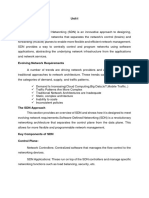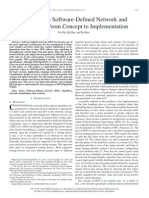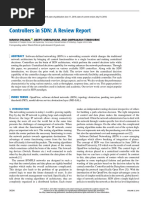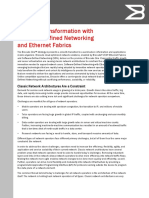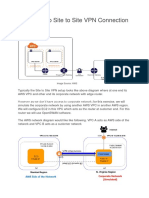18TE72 - Wireless Communication Experiential Learning Report
18TE72 - Wireless Communication Experiential Learning Report
Uploaded by
Ritika BakshiCopyright:
Available Formats
18TE72 - Wireless Communication Experiential Learning Report
18TE72 - Wireless Communication Experiential Learning Report
Uploaded by
Ritika BakshiOriginal Title
Copyright
Available Formats
Share this document
Did you find this document useful?
Is this content inappropriate?
Copyright:
Available Formats
18TE72 - Wireless Communication Experiential Learning Report
18TE72 - Wireless Communication Experiential Learning Report
Uploaded by
Ritika BakshiCopyright:
Available Formats
18TE72 - Wireless Communication
Experiential Learning Report
On
“Comparison of Conventional Networks and SDN”
Submitted by
Chirag Bakshi 1RV18TE008 chiragbakshi.te18@rvce.edu.in
Kushal Agarwal 1RV18TE020 kushalagarwal.te18@rvce.edu.in
Under the guidance of
Ms. Neethu S
Associate Professor
Dept. of Electronics & Telecommunication Engineering
RV College of EngineeringⓇ
Bengaluru
Dept. of Electronics & Telecommunication Engineering 1
TABLE OF CONTENTS
Sl TITLE PAGE
No.
1 Abstract 3
2 Introduction 3
3 Background Theory 4
4 Objective 4
5 Hospital Segments 4
6 Features and Services 4
7 Cost of Network 4
8 Definitions 5
9 MODEL STRUCTURE 6-7
9 Network Configuration 7
10 Conclusion 8
Dept. of Electronics & Telecommunication Engineering 2
1. ABSTRACT
The Internet has caused the advent of a digital society; wherein almost everything is
connected and available from any place. Thus, regardless of their extensive adoption,
traditional IP networks are yet complicated and arduous to operate. Therefore, there
is difficulty in configuring the network in line with the predefined procedures and
responding to the load modifications and faults through network reconfiguring.
The current networks are likewise vertically incorporated to make matters far more
complicated: the control and data planes are bundled collectively. Software-Defined
Networking (SDN) is an emerging concept which aims to change this situation by
breaking vertical incorporation, promoting the logical centralization of the network
control, separating the network control logic from the basic switches and routers, and
enabling the network programming.
SDN makes it less difficult and facilitates to make and introduce new concepts in
networking through breaking the issue of the network control into tractable parts,
simplifies the network management and facilitates the development of the network. In
this paper, the SDN is reviewed; it introduces SDN, explaining its core concepts, how it
varies from traditional Furthermore, we presented the crucial advantages and challenges
of SDN security, flexibility, and performance.
2. INTRODUCTION
2.1 Traditional Networking vs. SDN
As networks are increasingly growing in size and requirements, navigating hardware
switches has become a challenge. Setting up individual network software switches
manually has been very complicated and time-consuming for businesses running highly
virtual systems alongside large networks. This is where SDN comes into the game. SDN
can be described as a network approach that enables network operators to
programmatically set up, track, change and control network operation through
open interfaces such as the OpenFlow.
The SDN transforms the operation, management, and configuration of the network
infrastructures.
● The SDN's view is based on separating the data plane from the control plane.
● SDN proposes to concentrate network intelligence on a single network
component by distinguishing the data packet forwarding mechanism (data
plane) from the routing process (control plane).
In this paper, the SDN is reviewed; it introduces SDN, explaining it varies from
traditional networking, and its architecture principles. Furthermore, we presented the
crucial advantages and challenges of SDN.
Dept. of Electronics & Telecommunication Engineering 3
3. BACKGROUND THEORY
For the control plane, traditional networking implements a distributed paradigm. For each
network device, protocols such as ARP, STP, OSPF, EIGRP, BGP, and others operate
independently.
These network devices connect, but no centralized machine manages the whole network
or summarizes. The most critical difference between conventional networking and SDN
is that traditional networking is hardware-based, whereas SDN is usually software-based.
SDN is more versatile since it is software-based, helping users better control and ease
handling resources remotely in the control plane and facilitates making and introducing
new concepts in networking through breaking the issue of the network control into
tractable parts, simplifies the network management and facilitates development of the
network.
In this paper, the SDN is reviewed; it introduces SDN, explaining networking, and its
architecture principles. , focusing on scalability, networking based, whereas SDN is
usually more versatile helping users better control and ease handling.
Fig1. Architecture of SDN
Traditional networks utilize switches, routers, and other physical hardware to produce
connections and operate the network. A northbound interface that communicates with
Application Programming Interfaces (APIs) is used in SDN controllers. Because of this
Dept. of Electronics & Telecommunication Engineering 4
connectivity, device developers, as opposed to using the protocols required for
conventional networking, can explicitly program the network. Conventional networks are
used to mount all data planes and control aircraft in one physical unit and then to share
their capacity, increase the traffic load and the burden on the CPU and memory in two
processes. Detachments of control planes and data planes in SDN can be easily monitored
and managed by the controller and network to take the right ride decisions and thus
enable the network to better configure with a less traffic load, by separating these
processes and having a dedicated server. SDN is considered a popular alternative to
traditional networking because it allows IT managers to provide extra physical
infrastructure services and bandwidths without requiring an investment. In order to
expand the network power, traditional networking requires new hardware.
Fig2. Architecture of the traditional network and SDN.
Dept. of Electronics & Telecommunication Engineering 5
The main differences between the traditional networking architecture and SDN
architecture as clarified in Table 1.
Table 1.
Fig3. Centralizing control plane
● It can be defined as a control layer.
● It encompasses a series of software-based SDN controllers that provide
a centralized control defined API to oversee network forwarding actions
through an open .
● Generally, The control plane consists of three primary layers: the device
layer, the network operating system layer, and the To connect with t
Dept. of Electronics & Telecommunication Engineering 6
4. BENEFITS OF SDN
Benefits of SDN One of SDN's key benefits is that it provides a platform for
promoting more data-intensive software, for instance, virtualization and big data.
4.1 Centralized networking management SDN can control the whole network
from a centralized unit called a central node to automate network administration and
security and ensure that security and policy knowledge is reliably communicated across
the organization
4.2 Reduced hardware costs SDN uses the software principle to create a network
with the minimal hardware available, removing the need for manual assistance and the
expense of setup by leveraging the organizational performance and improving network
usage by utilizing the virtualization concept.
4.3 Cloud abstraction Cloud computing is here to remain, and a unified
infrastructure is emerging. It is easier to unify cloud services by abstracting cloud
infrastructure using SDN. The networking elements that make up large data center
systems can all be controlled.
4.4 Security approach It gets easier to track and control the security features
when there is a single management console for networking. It may not have to deal with
several applications around the system or be dependent on them. It operates from one
central point easily and provides a better security strategy. When there is a security-
related alarm, the same console may also be used to disperse information. In order to
keep up with network management, virtualization has made it more complex for IT
administrators. Applying filtering rules and firewalls can be challenging for many virtual
devices connected to the physical networks. With SDN, it is possible to monitor and
spread all information and safety measures consistently within the organization.
4.5 Automation Today's network does not have to deal with internet access,
unlike before. With SDN, it is also possible to adjust the cloud's automatic responses. In
environments like enterprise-wide SD-WAN networks, the process works well
5. CHALLENGES OF SDN
Even though SDN is identified as the basic solution to the problems that the infrastructure
of the expanding network is facing, it is still in its infancy phase. In addition to many
others, advantages such as better functionality, lower cost, and higher efficiency have
been laid out, but different challenges also demand attention. Challenges arise as SDN is
generally accepted and new alternatives are being suggested providing limited internet
access for the visitors.
Dept. of Electronics & Telecommunication Engineering 7
6. SCALABILITY
The main problems faced by SDN are scalability. From this single problem,
two sub-issues can be extracted:
(a) scalability of the controller
(b) scalability of the network node.
A single controller can handle up to 6 million flows per second. Therefore, this
demonstrates that for a large number of data forwarding nodes, only one controller
or several controllers can manage control plane services needed. To enhance
scalability, rather than functioning on a peer-to-peer basis, the logically centralized
controller should be physically distributed. However, the problems faced by the
controller when interaction happens will be shared between network nodes,
whether it be a distributed or peer-to-peer controller network. Hyper Flow and
Onix are known as efficient means of achieving scalability. Through allocating and
partitioning network status to separate physically dispersed controllers, Onix runs.
HyperFlow is an application that allows for the interconnection of OpenFlow
networks that are individually controlled. Specifically, the events that allow
changes to the network condition will be distributed by the HyperFlow program,
then all the distributed events will be replayed by the other controllers to reproduce
the situation. As such, with the same homogeneous network topology, any
controller will operate.
7. SURVEY DISCUSSION & ANALYSIS
Traditional networks are complicated and difficult to control. Most of the reasons for this
are that data and control planes are vertically integrated and specific to the manufacturer.
SDN provided an opportunity to resolve these long-standing issues by decoupling the
Data plane and Control plane, making the network more flexible and centralized the
control network. For this reason, many studies focused on SDN and its utilization instead
of traditional networking.
The authors showed that using the SDN approach within networks decreases packet loss
and increases the bandwidth. The study presented a secure and systemic SDN framework
capable of avoiding spoofing attacks and DoS with a common SDN router configuration
overhead. The reference [84] proposed TEDR algorithms that can achieve optimum
connection use if the SDN nodes are deployed as 30 percent as complete SDN and have a
small effect on routing efficiency. The research explored that using SD Guardian can
reduce table-miss special attacks. The authors showed that edgebased control on the
centralized SDN controller could significantly handle higher network load while
maintaining lower latency. The reference found that by using the MCBLB algorithm in
the SDN network, the load balancing is increased by up to 14 %.
Dept. of Electronics & Telecommunication Engineering 8
The author discussed how to prevent ARP spoofing without using any additional
hardware and software but only by extending the SDN controller by a module. The
results of the simulation showed that the suggested mechanism is stable against the attack
of ARP spoofing. The clarified that using sFlow technology embedded in the controller
shows that the method can detect and reduce DDoS attacks. The study discussed that
SDN provides a mechanism allowing the use of flow rules to modify and re-program the
data plane easily. They developed optimization architecture and associated flow
configuration algorithms that reduce the configuration time by 55% and average time to
recover interrupted flows by 40 %. The showed that under DoS attacks, Flow Keeper
maintains more than 80 percent bandwidth and can prevent unauthorized topology
changes by screening out forged LLDP packets. The authors explored that Phish Limiter
is an efficient and effective solution for detecting and preventing phishing attacks within
SDN networks. The reference demonstrated an inverse relation between the unit cost of
the service and the control scalability of the architecture where more scalable architecture
contributes to lower unit cost of service. The research found that using SDN-Guard the
DoS attacks on the performance of SDN controllers decreased by up to 32%. The authors
showed that SDN can benefit from big data, where big data and SDN joint design will
become a promising approach for networking big data.
CONCLUSION
SDN is an evolving networking paradigm that enables a standardized programming
capability to control network behavior. Since SDN is a modern approach to networking,
this architecture has been used to redesign various solutions to classical network
problems, while several issues remain challenging. SDN provides efficient and automatic
control of the network that meets the need for increased complexity of the network and
many other software domains. This paper reviewed the SDN networking paradigm design
with the related open study challenges and revised some of the work performed with each
challenge, including scalability, security, reliability, and performance. Moreover, several
certain issues in SDN still require additional study attention to prevent inherited issues
from the legacy networks, like standardizing the SDN modules and introducing new
unique procedures developed for SDN. To develop innovative ideas for controllers that
are the brains of the SDN design, the study needs to concentrate more on the control
plane. As the control plane is a point of failure for the entire network, several security
measures should be considered.
As a result, SDN plays a vital role in redesigning various solutions to classical network
problems, while several issues remain challenging. It also provides efficient and
automatic control of the network that meets the need for increased complexity of the
network and many other software domains.
An unsuccessful attempt to invest in a new deal left a start-up cautious. We helped them
to work out what the consumer actually needs to buy with Service Design. The emphasis
Dept. of Electronics & Telecommunication Engineering 9
on customer travel actually dominates the service architecture, such that the increasingly
diverse problems facing public institutions and industries are not enough in itself. The
combination of structural architecture capability and an interdisciplinary approach is vital
for tackling diverse problems in the public sector.
Dept. of Electronics & Telecommunication Engineering 10
You might also like
- TI - 20210113 - Logger - Communication Protocol - V1.0.2.5 - ENDocument6 pagesTI - 20210113 - Logger - Communication Protocol - V1.0.2.5 - ENCarlos KaduNo ratings yet
- The Internet MultimediaDocument8 pagesThe Internet MultimediaAngelica EstipularNo ratings yet
- 20410A - Module - 00Document12 pages20410A - Module - 00AdewaleNo ratings yet
- Traditional Network Architecture and SDNDocument9 pagesTraditional Network Architecture and SDNAqeel ZaffarNo ratings yet
- The Future of Software-Defined Networking (SDN)Document2 pagesThe Future of Software-Defined Networking (SDN)taosmonsta11No ratings yet
- Software-Defined Networking and Its Induction in Cloud Computing A Newer Approach To Networking and Modernizing The CloudDocument10 pagesSoftware-Defined Networking and Its Induction in Cloud Computing A Newer Approach To Networking and Modernizing The CloudInternational Journal of Innovative Science and Research TechnologyNo ratings yet
- SDN in Wide-Area Networks A SurveyDocument6 pagesSDN in Wide-Area Networks A SurveyAbizwagNo ratings yet
- Abdullah 2018Document45 pagesAbdullah 2018mohammed meladNo ratings yet
- 07 Performance Evaluation of Data Center Network With Network Micro-SegmentationDocument6 pages07 Performance Evaluation of Data Center Network With Network Micro-SegmentationSilver RogerNo ratings yet
- Software Defined Networking: An Overview: Alexander Nunez Joseph Ayoka MD Zahidul Islam Pablo RuizDocument6 pagesSoftware Defined Networking: An Overview: Alexander Nunez Joseph Ayoka MD Zahidul Islam Pablo RuizaliNo ratings yet
- (IJCST-V3I5P29) : Mr. Sachin Ashok Vanjari, Dr. R. B. IngleDocument5 pages(IJCST-V3I5P29) : Mr. Sachin Ashok Vanjari, Dr. R. B. IngleEighthSenseGroupNo ratings yet
- Seminar Synopsis FormatDocument3 pagesSeminar Synopsis FormatMallesh KumarNo ratings yet
- Traffic Engineering SDN SurveyDocument12 pagesTraffic Engineering SDN SurveyRafael FGNo ratings yet
- Simulation Analysis of Characteristics and Application of Software-Defined NetworksDocument6 pagesSimulation Analysis of Characteristics and Application of Software-Defined NetworksS M Shamim শামীমNo ratings yet
- Implementation of An SDN Based IoT Network Model For Efficient Transmission of Sensor DataDocument7 pagesImplementation of An SDN Based IoT Network Model For Efficient Transmission of Sensor DatasanthanNo ratings yet
- Report Format No4r345Document34 pagesReport Format No4r345likhithp1ga20is067No ratings yet
- Software Defined NetworkingDocument23 pagesSoftware Defined NetworkingNiamNo ratings yet
- Software Defined NetworksDocument18 pagesSoftware Defined NetworksAhsan RiazNo ratings yet
- Enabling Secure Software-Defined Networking For Wireless and Cellular Networks Through VirtualizationDocument7 pagesEnabling Secure Software-Defined Networking For Wireless and Cellular Networks Through VirtualizationParanthaman GNo ratings yet
- Evaluation Method For SDN Network Effectiveness in Next Generation Cellular NetworksDocument8 pagesEvaluation Method For SDN Network Effectiveness in Next Generation Cellular NetworksChaimaa GhazzaouiNo ratings yet
- SDN Unit 1 NotesDocument9 pagesSDN Unit 1 Notesdinesh kumarNo ratings yet
- White Paper - : Enabling Smart Software Defined NetworksDocument16 pagesWhite Paper - : Enabling Smart Software Defined NetworksCristina Messina100% (1)
- Ts 16Document25 pagesTs 16المؤسس عثمان بن ارطغرلNo ratings yet
- SDN PDFDocument2 pagesSDN PDFAyeshaNo ratings yet
- SDN Controller PcepDocument43 pagesSDN Controller PcepwallacemariadeandradNo ratings yet
- Software-Defined Networking: State of Art and Research ChallengesDocument24 pagesSoftware-Defined Networking: State of Art and Research Challengesj.nyambeyaNo ratings yet
- 1.5038976Document8 pages1.5038976huaweiudpNo ratings yet
- Fa22 BCS 147 (CN3)Document7 pagesFa22 BCS 147 (CN3)Bilal RammyNo ratings yet
- A_survey_on_SDN_the_future_of_networkingDocument17 pagesA_survey_on_SDN_the_future_of_networkingkinip43057No ratings yet
- Improving Security Through Software Defined Networking (SDN) : AN SDN Based ModelDocument6 pagesImproving Security Through Software Defined Networking (SDN) : AN SDN Based Modelj.nyambeyaNo ratings yet
- High Performence SDWLANDocument21 pagesHigh Performence SDWLANadroidtivi178No ratings yet
- sdn41476-019-0105-4Document15 pagessdn41476-019-0105-4guptarpg.1784No ratings yet
- Hakiri Et Al. - 2014 - Software-Defined Networking Challenges and Research Opportunities For Future InternetDocument19 pagesHakiri Et Al. - 2014 - Software-Defined Networking Challenges and Research Opportunities For Future InternetShaun NevilleNo ratings yet
- 4th UnitDocument8 pages4th UnitCh Shanthi PriyaNo ratings yet
- Hu 2014Document27 pagesHu 2014Noor FatimahNo ratings yet
- 06819788Document26 pages06819788Allan LeandroNo ratings yet
- Journalism Research PaperDocument14 pagesJournalism Research Paperrikaseo rikaNo ratings yet
- Software_Defined_Networking_ArchitectureDocument22 pagesSoftware_Defined_Networking_Architecturekinip43057No ratings yet
- Habusadeh, Journal Manager, 854 - 859Document6 pagesHabusadeh, Journal Manager, 854 - 859Mohamed YaCine LaidaniNo ratings yet
- Controllers in SDN A Review ReportDocument15 pagesControllers in SDN A Review ReportNoureddine OubahaNo ratings yet
- Network TransformationDocument6 pagesNetwork TransformationMumtaz AhmadNo ratings yet
- cutter15_enterprise_sdnDocument7 pagescutter15_enterprise_sdnCarlos JesusNo ratings yet
- CS-702(C) WMC-Unit 1Document31 pagesCS-702(C) WMC-Unit 1Raj ThakurNo ratings yet
- SDNDocument14 pagesSDNSara Nieves Matheu GarciaNo ratings yet
- F-IoT Unit-4Document101 pagesF-IoT Unit-4Harshini Reddy RevuriNo ratings yet
- SDN NotesDocument98 pagesSDN Notessubhasuji86No ratings yet
- SDN Based Mobile Networks: Concepts and Benefits: Slavica Tomovic Igor RadusinovicDocument16 pagesSDN Based Mobile Networks: Concepts and Benefits: Slavica Tomovic Igor RadusinovicapatiyehNo ratings yet
- Iot Unit Iv R22Document6 pagesIot Unit Iv R22Vibha MaithreyiNo ratings yet
- Learning Journal Unit2 - CS 4404-01 - AY2025-T2Document2 pagesLearning Journal Unit2 - CS 4404-01 - AY2025-T2DJELLOUL ELMILOUDINo ratings yet
- NFV SDNDocument6 pagesNFV SDNPT. Telemedia Prima NusantaraNo ratings yet
- SDN and NFVDocument15 pagesSDN and NFVantonioengrafNo ratings yet
- Pre Print Comnet2014Document7 pagesPre Print Comnet2014Boopathy PandiNo ratings yet
- Unit 5- Software Defined NetworkDocument6 pagesUnit 5- Software Defined Networkkmahalakshmi1345No ratings yet
- Software Defined Networking Challenges and FutureDocument9 pagesSoftware Defined Networking Challenges and FuturePhu nguyen doanNo ratings yet
- Notes For SDNDocument11 pagesNotes For SDNtguna21No ratings yet
- Assignment: Software Defined Networking (SDN)Document12 pagesAssignment: Software Defined Networking (SDN)Rosemelyne WartdeNo ratings yet
- Computer Networks: Manar Jammal, Taranpreet Singh, Abdallah Shami, Rasool Asal, Yiming LiDocument25 pagesComputer Networks: Manar Jammal, Taranpreet Singh, Abdallah Shami, Rasool Asal, Yiming LiAlexandra ComșaNo ratings yet
- CS Presentation 5Document1 pageCS Presentation 5qjljndooiqmvwxkowmNo ratings yet
- SD WANFutureofNetworkingDocument7 pagesSD WANFutureofNetworkingYousef AldrisiNo ratings yet
- Software Defined Network MininetDocument24 pagesSoftware Defined Network MininetIT'S SIMPLENo ratings yet
- SDN1Document39 pagesSDN1KieylNo ratings yet
- Software Defined Networking (SDN) - a definitive guideFrom EverandSoftware Defined Networking (SDN) - a definitive guideRating: 2 out of 5 stars2/5 (2)
- Networking Programming with C++: Build Efficient Communication SystemsFrom EverandNetworking Programming with C++: Build Efficient Communication SystemsNo ratings yet
- Fortigate Troubleshooting 50Document74 pagesFortigate Troubleshooting 50xandnascimento100% (1)
- Ubuntu 18.04 Linux Inbox Driver User Manual: Mellanox TechnologiesDocument13 pagesUbuntu 18.04 Linux Inbox Driver User Manual: Mellanox TechnologiesgarciamaxNo ratings yet
- Multi-Channel MAC For Ad Hoc NetworksDocument54 pagesMulti-Channel MAC For Ad Hoc NetworksHassan HassanNo ratings yet
- Single Sign-On With SAP Netweaver 7.3Document10 pagesSingle Sign-On With SAP Netweaver 7.3Kondapalli SrinuNo ratings yet
- 18CS726 - IOT Protocols and Architecture - Quiz1Document3 pages18CS726 - IOT Protocols and Architecture - Quiz1Ujjwal KumarNo ratings yet
- FORMATO PKL - TO Rev Proy Claro V2Document14 pagesFORMATO PKL - TO Rev Proy Claro V2Vanessa MelgarejoNo ratings yet
- SKR 4401Document53 pagesSKR 4401AboodylotusNo ratings yet
- Cat9k Access PortfolioDocument58 pagesCat9k Access PortfolioKha NguyenNo ratings yet
- Microsoft - Examwhale.70 513Document86 pagesMicrosoft - Examwhale.70 513Sherif A. KamelNo ratings yet
- Analysys Mason - Network Slicing - THE FUTURE OF CONNECTIVITY IN A 5G 2018Document10 pagesAnalysys Mason - Network Slicing - THE FUTURE OF CONNECTIVITY IN A 5G 2018Andrey PritulyukNo ratings yet
- AWS Setup Site To Site VPN ConnectionDocument8 pagesAWS Setup Site To Site VPN Connectionmr KNo ratings yet
- Barun - Dey ResumeDocument4 pagesBarun - Dey Resumessingh7610No ratings yet
- Topology Mind-MapDocument1 pageTopology Mind-Mapmitchlovemore2No ratings yet
- Arris DCS 3600 User GuideDocument42 pagesArris DCS 3600 User GuideAnonymous GXeRp98TbFNo ratings yet
- BGP OSPF Admin Two Router SiteDocument3 pagesBGP OSPF Admin Two Router Sitepisanij123No ratings yet
- 8000 SeriesDocument299 pages8000 SeriesKeith Bostwick100% (1)
- Datasheet Axis A1610 Network Door Controller 230207 en US 396886Document2 pagesDatasheet Axis A1610 Network Door Controller 230207 en US 396886Prayudo K WardhanaNo ratings yet
- SALSA A Scheduling Algorithm For LoRa To LEO SatelDocument8 pagesSALSA A Scheduling Algorithm For LoRa To LEO SatelJúlio SantosNo ratings yet
- Slack Incident Jan 04 2021 RCA FinalDocument3 pagesSlack Incident Jan 04 2021 RCA FinalAnjali karnikaNo ratings yet
- Configuracion Basica Switch y RouterDocument4 pagesConfiguracion Basica Switch y RouterPaul Andres Heredia FerrufinoNo ratings yet
- Sinec h1Document8 pagesSinec h1fiorinalavacca500No ratings yet
- Command Center RX User GuideDocument87 pagesCommand Center RX User GuideJohn GreeseNo ratings yet
- Cri 327 - Ulob ToolkitDocument52 pagesCri 327 - Ulob ToolkitLYLE DALE AVANCENo ratings yet
- 06-Communications and Computer NetworkingDocument28 pages06-Communications and Computer NetworkingM. RazaNo ratings yet
- Case Study Ethical HackingDocument10 pagesCase Study Ethical HackingSivaneka SevamNo ratings yet
- Phishing Attack: Anatomy of A ModernDocument12 pagesPhishing Attack: Anatomy of A ModernDanny Luna100% (1)
- 02 Open MGW Platform IntroductionDocument54 pages02 Open MGW Platform Introductiongaussyn100% (2)




















